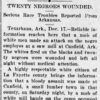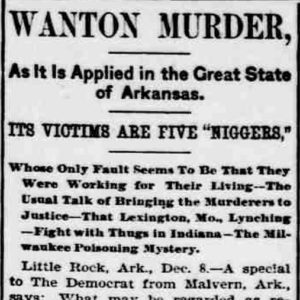calsfoundation@cals.org
Southern Arkansas Race Riots of Late 1896
During November and December 1896, there were three separate racial incidents on job sites in and around El Dorado (Union County). In mid-November 1896, there was a “race war” between white and Black workers at Hawthorne Mills, twelve miles southwest of El Dorado. On Tuesday, December 1, 1896, five African-American section men who were working on the line of the Cotton Belt Railroad between Camden (Ouachita County) and Bearden (Ouachita County) were killed by a group of unidentified men. In late December, near McNeil (Columbia County), approximately twenty African Americans were shot when white men raided a sawmill.
This was part of a widespread pattern of intimidation of Black laborers in southern Arkansas in the 1890s, a practice that seems to have reached a peak in 1896 and 1897. There were other incidents involving railroad workers in Polk County in August 1896 and lumber workers near Prescott (Nevada County) in July 1897. It became common for white tenant farmers, timbermen, and railroad workers to band together to drive out Black workers, who were paid less and thus were more attractive to employers. Sometimes this was done by whitecappers or nightriders who threatened Blacks, hoping to drive them off. When threats did not work, the whites sometimes resorted to outright violence, including lynchings, whippings, shootings, and, in the Prescott case, arson.
At Hawthorne Mills, Black and white workers began waging a so-called race war on Monday, November 9. The Tombstone Prospector of Tombstone, Arizona, reported on November 13 that several African Americans had already been killed and the sheriff was on his way to investigate. An article in the Kansas City Daily Journal of Kansas City, Missouri, that same day, subtitled “White Men Try to Drive out Negro Laborers Employed in Mills near El Dorado,” indicated that the whites, who were outnumbered by the Blacks, had warned the Blacks to leave, and the Blacks took no notice. Subsequently a mob of armed white men surrounded a makeshift camp in which the Black workers were sleeping and fired over 100 shots into it. Reports did not indicate how many Blacks were shot, but a woman was wounded and expected to die. There was further rioting on November 11. A sheriff and posse were on hand to try to defuse the situation, and the lumber mills were idle on November 12, with neither whites nor African Americans at work.
The following day, the Daily Record-Union of Sacramento, California, reported that, in the time between the warning given by the whites and the subsequent shooting, one of the Black workers was severely whipped by several white men. The shots into the camp were apparently intended just to frighten the Blacks, because when the shooting stopped, they were once again warned to leave “on pain of death.” The sheriff and deputies were on the scene, but new reports indicated that the wounded woman had died, and more trouble was expected as the Blacks attempted to avenge her death.
On Tuesday, December 1, 1896, five Black section men who were working on the line of the Cotton Belt Railroad between Camden and Bearden were killed by a group of men. According to an article datelined Little Rock (Pulaski County), December 7, and published in the St. Paul Globe of St. Paul, Minnesota, the following day, a gang of section men, “composed principally of negroes, with a white foreman,” was working on improving the roadbed when a “gang of unknown persons” appeared without warning and began firing into the crowd. As a result, five workers were killed. The white foreman stated that he did not recognize any of the attackers. The Globe called the incident “one of the foulest massacres of negroes that has ever blackened the record of that locality.”
A report originating from Malvern (Hot Spring County), which appeared in the Arkansas Democrat and was reprinted in the Waterloo Daily Courier of Waterloo, Iowa, on December 8, added a bit more to the story. According to the Courier, many people in the area believed that the foreman “knows who they [the killers] are but on account of probability of personal danger to himself he is afraid to give out any information that would lead to their arrest.” The area where the attack occurred was said to be “occupied almost entirely by the mills and is filled with lawless characters.” The Cotton Belt Railroad Company had offered a reward for the murderers’ capture, and the sheriff of Ouachita County was attempting to apprehend the perpetrators. In a departure from some similar situations during this era, the Courier claimed: “If they are captured it is believed the courts of Ouachita County will mete out swift justice to them.” According to a later report, published in the Sausalito News of Sausalito, California, on December 19, 1896, and datelined Malvern, Governor James Paul Clarke of Arkansas subsequently stated that he had no information on the incident and placed no credence in it.
There is scant information on the incident at McNeil in late December 1896. Columbia County, the only Arkansas county not situated on a river, was sparsely populated. The population in 1890 was less than 20,000. McNeil itself was not incorporated until 1884, two years after the construction of the St. Louis, Arkansas and Texas Railroad, which passed through town. On Christmas Day, the Wichita Daily Eagle of Wichita, Kansas, reported that twenty Blacks had been shot there “recently” when white men raided a sawmill. Although the mill was still running full-time, the trouble had not yet subsided and officials feared that “war may break out afresh at any time.” Although a number of other newspapers reprinted this same article, there was apparently no further information given.
For additional information:
“Arkansas’ Race War.” Wichita Daily Eagle, December 26, 1896, p. 1.
“Arkansas Scene of a Bloody Race War.” Tombstone Prospector, November 13, 1896, p. 1.
Matkin-Rawn, Story L. “‘We Fight for the Rights of Our Race’: Black Arkansans in the Era of Jim Crow.” PhD diss., University of Wisconsin–Madison, 2009.
“Negroes Massacred.” St. Paul Globe, December 8, 1896, p. 5.
“Notes by Mail and by Wire.” Sausalito News, December 19, 1896, p. 1.
“Race War.” Sacramento Daily Record-Union, November 14, 1896, p. 1.
“Race War in Arkansas.” Kansas City Daily Journal, November 13, 1896, p. 2.
“Wanton Murder As It Is Applied in the Great State of Arkansas.” Waterloo Daily Courier, December 8, 1896, p. 2.
Nancy Snell Griffith
Presbyterian College
 Canfield Race War of 1896
Canfield Race War of 1896 Race Riot Article
Race Riot Article 




Comments
No comments on this entry yet.